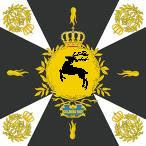Progress on Luftberg continues - all infantry are now painted up to their coat facings, plus I've now saved up enough to order the rest of my figures. For a moment however, it's time to turn attention to their foes in Aschenbach and repeat the brigade organising process.
The Aschenbach army organisation proved to be a lot easier than I had thought. After the massed hordes of Luftberg’s army, the relatively fragile Aschenbach machine proved a lot easier to break down.
The guiding philsosphy: hard hitting groups of specialists! In Might & Reason (as in real life, historically speaking) the Prussian/Aschenbach army is good for striking hard and fast, and – well, that’s about it. So, with this in mind, here’s the logic:
First up, the infantry – the Luftberg style of four regiments plus artillery won’t do. The whole Aschenbach army contains six line regiments in total, so straight away we’re cutting the size of a brigade to three regiments. In keeping with the logic of producing a hard spear-tip for the army in attack, I knew right from the start that my two regiments of grenadiers would get put into a single ‘Guards’ brigade. At three regiments a brigade, that gives them a regular line regiment for backup to their mitre-hatted brilliance.
Next: artillery. In M&R, only gun-crazy armies like the Russians get a specific artillery brigade with it’s own commander, but the armies can keep artillery aside in a central ‘army reserve’ unde the direct whim of the general. I decided to do this in the end, creating a little artillery park for Feldmarschall Von Krumper rather than disperse them piecemeal. Now, in the style of later-years SYW Prussians, our bluecoats can use massed artillery to blast an opening in the enemy line as
So, the Aschenbach army stands at a 'Guards' infantry brigade, two ‘regular’ infantry brigades; a ‘heavy’ and a ‘light’ cavalry brigade; plus an army artillery reserve. By pure coincidence, six formations – just like Luftberg.


1 comment:
Sounds very practical and deadly!
Post a Comment